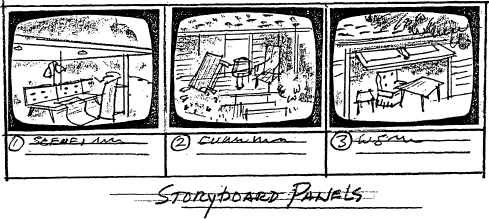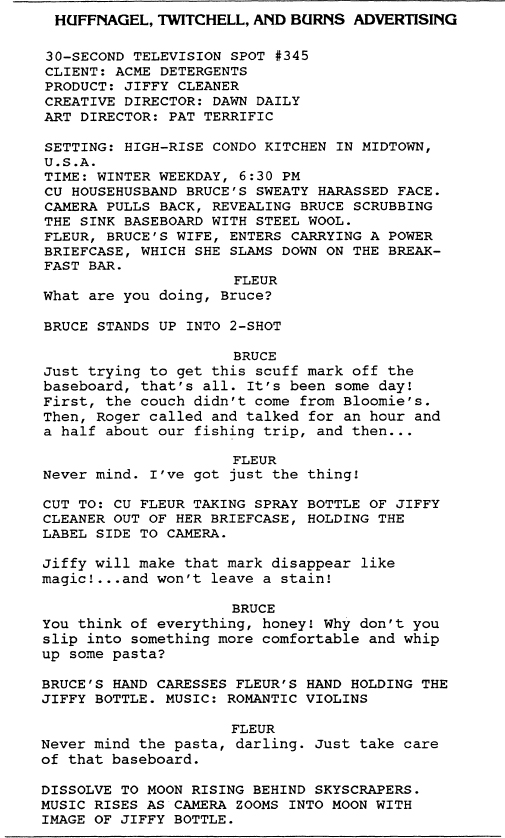Besides giving us time to dash to the kitchen for a snack, television commercials support programming that keeps us on the couch in the first place. Jean Carpenter, an art director specializing in commercials, says:
I like designing commercials because they don’t last forever, pay well, and many times offer creative opportunities that don’t happen in dramatic work. What I don’t like is the need to satisfy so many different elements such as the client’s personal opinion which has nothing to do with the finished product. I worked for a producer once who didn’t allow the client people on the set! She made that whole group stay in a viewing room and watch production on a monitor!
A commercial’s objective is to sell a product, of course. By interviewing consumers and by analyzing sales and demographic data, advertising agencies create messages they hope will cause consumers to buy their product instead of a competitor’s. Buyers’ choices may not have any bearing on the intrinsic worth of the product, but can simply be a response to the message and its atmosphere. The art director, then, as a participant in the creation of environments, helps sell products.

What is the difference between an advertising agency art director and a video or film art director? The answer is: An agency art director works with a creative director to create a storyboard and general visual concept for a commercial.
A storyboard is a series of drawings in panels with dialogue or description below each drawing. The video or film art director works from the storyboard and script and creates the sets.
Visual Consultant Bruce Block says:
Storyboards should be simple. They should remind you of the general composition and who’s in the shot. They should deal with spatial considerations and line and that’s about it. Storyboards should be a work in progress; otherwise, they’re comic book illustrations.
COMMERCIAL PRODUCTION PERSONNEL AND PROCEDURES
An advertising agency frequently hires an outside production house to package the production of the commercial. The production house may also hire the set art director.
The advertising agency personnel usually include the following:
• Account executive
• Producer
• Creative director
• Copywriter
• Agency art director
The production house generally provides the following:
• Director
• Art director
• Set decorator
• Food stylist
• Director of photography (DP)
• Stage facility
• Stage crew
• Postproduction services
Differences of opinion affect the commercial art director’s job. The client may not like the wallpaper, the set dressing, or the paint color. The producer has the final say and may have to work out compromises; this is another time when the art director needs to be diplomatic.
Daily Labor
The set art director is usually hired to work on a daily basis rather than under a contract agreement. The amount of time available to design and assemble the set elements is generally short, frequently just three or four days. The client, of course, wants to know exactly what the sets are going to look like, so an art director’s sketches play a major role and have to be done very quickly.
Labeling and Food
Usually the advertising agency prepares camera-ready labels and special packaging that will photograph better than a store’s shelf products. Larger production centers have services that specialize in product labels and packaging, but frequently the prop person or art director handles that part of the job using airbrush, photocopies, and laser prints. If the product is a food item, the agency or production house will hire a food stylist who knows how to attractively prepare and present food for the camera.
Sketches and Plans
If sets are to be built, the video or film director prepares plans using the same process as for a dramatic production: sketches, construction drawings, and bids. Very short time frames may preclude the construction drawing process, and the shop may have to put together stock flats from a sketch on a paper towel, not the best way to go.
Money Matters
Some set art directors who specialize in commercials contract their services for a flat fee, which may include construction costs, helpers, and props. This is OK for an experienced person to tackle, but if you are just starting out, it’s better to have the production house handle these elements. Never spend your own money because it’s frequently difficult to get it back again.
Now that the ground rules are entrenched in your mind, read the script.

Commercials present a lot of information in a short period of time. Each set element contributes to viewers’ perceptions of the characters, environment, and above all, the product’s virtues. In some cases, the product is the atmosphere created by a setting that communicates elegance, speed, efficiency, or other positive attributes.
Remember that you need to give the impression of a high-rise condominium building, but do not need to build the entire building; just a kitchen in the building. Select some set elements that communicate height and apartment building such as a window view showing that the building is high, and a doorway through which Fleur enters which shows a hallway not found in a tract home. Start with two walls set at a right angle to each other. One wall needs a door and the other wall needs a window, sink, and cabinets.
Set Improvements
Looks pretty dull, doesn’t it? Let’s improve this set. Add visual interest by putting the sink in a freestanding island with a work surface. This will bring Bruce’s problem scuff toward easy camera access and add three-dimensional interest to the set. Because the sink does not need running water, the island unit’s plumbing does not have to work and the unit can be positioned to satisfy the director’s every whim. The previous sink-below-the-window approach would have worked, but it would not have given the impression that Bruce and Fleur are up-scale people or make the director smile.

Turning our attention to the former sink wall, it holds the window through which we see the skyscrapers and moon, and the custom-built counter and trendy-color refrigerator, stovetop, expensive cannisters, and kitchen appliances which a couple like Bruce and Fleur would have but are actually rented from a property rental house by the set decorator. Remember that a couple like Bruce and Fleur would hardly have a set of cannisters shaped like teddy bears.
What about the Hallway?
Find out what elements exist in high-rise condo hallways. Perhaps the service elevator doors are across from the kitchen door, or a stairway with an EXIT sign. If the city-at-night backing you rent shows the skyscrapers from ground level, roll it up from the bottom to just show the across-the-street building’s upper floors.

Pay close attention to the crucial scuff area. See that the carpenters pay meticulous attention to this area because it will be seen in extreme closeup, which can reveal sloppy corner joints or flaws in the cabinet materials. The agency people will scrutinize the area where their product will work its magic. They will probably hire a kitchen stain and mess expert to create a scuff mark that can be easily removed.
In the preceding photograph, you see a commercial set for another cleaning product that gives a different impression than our high-rise example. Notice the lighting. A cheery shaft of sunlight pours through the window and light haze from a haze generator provides atmosphere between the window and the backing. The window design, ceiling beams, and set decoration objects give the sense of a different type of owner than the other example couple. Notice the economical construction, which includes only the elements to be seen on camera, and the production clutter of the lighting instruments and crew.
On the first shoot day, the art director hears a lot of comments – both positive and negative. Be flexible, willing to listen, and willing to change some things. As we have said before, personal taste enters into projects. If you have done the best job you can, be satisfied with that, and learn from whatever mistakes you may have made.
•
In the preceding chapters, we have seen examples of design and production successes as well as problems. The only way to get some real-life experience is to begin working in the art direction profession. Turn to the next chapter for some helpful tips on how to prepare and where to look.


